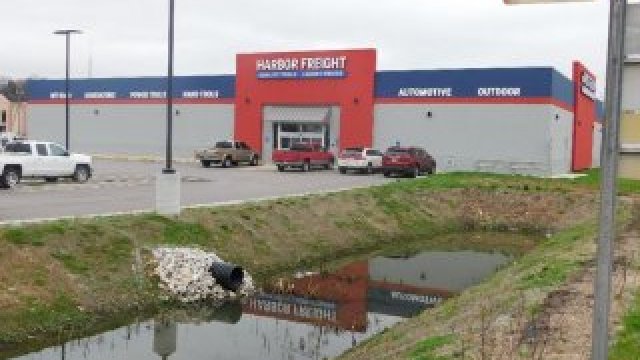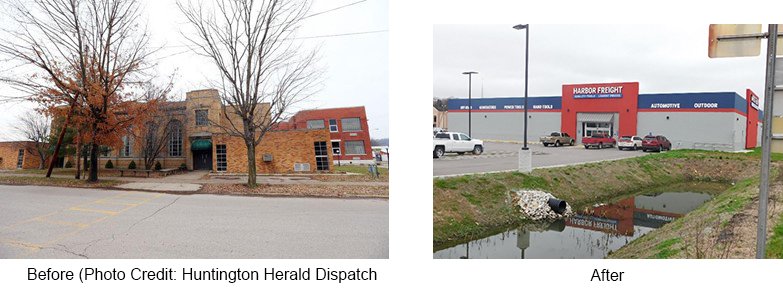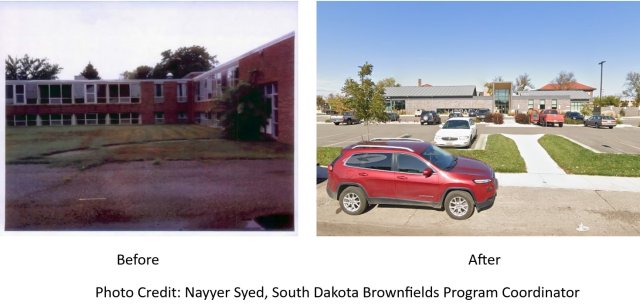Brownfields Reuse in Small and Rural Communities
-
Silver City, NM

Success Story: The Silver Lining in an Abandoned Hospital: Silver City, New Mexico
-
Wayne County, WV

Success Story: Wayne County Economic Development Authority, West Virginia
-
Aberdeen, SD

Success Story: Continuing a Legacy of Learning, Aberdeen, South Dakota
Small and rural communities often face common challenges when trying to find resources to address their brownfield sites, such as:
- A constrained local budget, which limits funding available to invest in brownfield assessment, remediation, and redevelopment activities.
- Fewer people available to manage brownfield projects and limited access to technical expertise.
- Plenty of large parcels and uncontaminated properties nearby, which lowers market demand for brownfields reuse.
Fortunately, many small and rural communities have built the partnerships and capacity they needed to attract investment for brownfields reuse. Check out these two examples.
EPA provides several free brownfields technical assistance resources that can benefit small and rural communities especially, including:
- Targeted brownfields assessments
- Technical assistance to brownfields communities providers
- 128(a) Technical Assistance Grants
- Land Revitalization technical assistance
Success rates for small and rural communities who apply for and are awarded an EPA's Brownfield Grant are on par with success rates from applicants with larger populations.
Success Rates Among Brownfields Multipurpose, Assessment, Revolving Loan Fund and Cleanup Grant Applicants
Success rate is defined as the number of applicants who are awarded an EPA's Brownfield Grant divided by the total number of applicants in a given year.

With the recent funding boost available through the Infrastructure Investment and Jobs Act, Brownfields Grant applicants from small and rural communities were selected for awards at nearly the same rate as applicants overall. This is great news for grant applicants from small and rural areas!
Examples of Brownfields Projects in Small and Rural Communities that Received Brownfields Funding
The Silver Lining in an Abandoned Hospital, Silver City, New Mexico

For nearly 25 years, Hillcrest General Hospital, located in Silver City, New Mexico (population 9,578), served as a healthcare hub for residents of Silver City and others in western New Mexico. In 1983, Grant County officials decided to build a new hospital, Gila Regional Medical Center, rather than make costly upgrades to Hillcrest resulting in the Hillcrest General Hospital being abandoned. The former hospital quickly fell into disrepair and earned a reputation among locals as an eyesore and a nuisance. In 2004, the town acquired the abandoned hospital and received a $168,393 Brownfields Assessment Grant for Phase I and Phase II environmental site assessments. The assessments revealed significant contamination—asbestos, lead, incinerator ash and animal droppings containing bacteria that could cause harm if inhaled by people visiting the structure. In 2007, the town then received a $342,560 Brownfields Revolving Loan Fund Grant to cover the costs of waste removal and building teardown. In 2017, the city donated the land to Bethel Development after they showed the city town needed affordable housing for their senior citizens. Construction was completed in 2019 and many of the 69 housing units are currently occupied.
Wayne County Economic Development Authority, West Virginia

The Wayne County Economic Development Authority received a $200,000 community-wide assessment grant in 2014 that helped fund a Phase I Environmental Site Assessment in the summer of 2016 for the former Kenova Elementary School, located in Kenova, West Virginia (population 2,978). The assessment found asbestos from multiple building materials. In 2016, the Wayne County Economic Development Authority received a $200,000 cleanup grant, which helped them abate the asbestos to make it ready for its future use. The site has been turned into a new retail store, Harbor Freight, which finished construction in the spring of 2024 and is now open.
Continuing a Legacy of Learning, Aberdeen, South Dakota

Bethlehem Lutheran Church has been a fixture in Aberdeen, South Dakota (population 28,210), since its founding in 1884. In 1956, the church built a two-story school on its grounds to accommodate the growing parish. When the parish relocated nearly 40 years later, the old buildings began to slowly deteriorate. In 2011, the City of Aberdeen acquired the property and requested EPA Brownfields assistance in performing an Environmental Site Assessment to determine the environmental conditions of the property so that they could prepare final plans for the redevelopment of the property
Recognizing the need to assess the site for potential contamination, the city applied to the South Dakota Department of Environment & Natural Resources (DENR) for funding to complete an Environmental Site Assessment. The assessment revealed asbestos in building materials and petroleum-contaminated soil. DENR then collaborated with the city to safely cleanup and remove the asbestos and petroleum.
Using Brownfields CERCLA 128(a) funding, the DENR spent approximately $45,000 to conduct the site assessments, develop a cleanup plan and remove the asbestos. The state also provided approximately $7,000 through the DENR Abandoned Tank Program to assess, remove and appropriately dispose of contaminated substances associated with a 6,000-gallon underground petroleum tank.
To fund construction for the new library, the City raised $5.5 million through a sales tax initiative and $2.5 million in private donations. The City was thrilled to open the new K.O. Lee Aberdeen Public Library on September 18, 2017.
